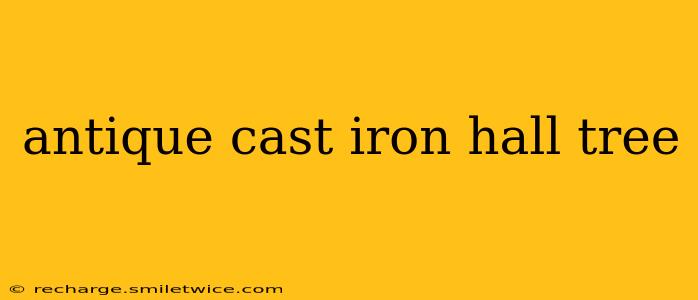Antique cast iron hall trees represent more than just a place to hang coats and hats; they are exquisite pieces of functional art that add undeniable character and charm to any home. These sturdy, beautifully crafted pieces offer a glimpse into the past, showcasing the craftsmanship and design aesthetics of bygone eras. Their enduring popularity speaks volumes about their timeless appeal and lasting quality. This guide delves into the world of antique cast iron hall trees, exploring their history, identifying features, and providing tips for finding and caring for these remarkable pieces.
What is a Cast Iron Hall Tree?
A cast iron hall tree is a freestanding piece of furniture typically found in entryways. It's characterized by its robust cast iron construction, featuring a central post supporting a series of hooks for coats, hats, and umbrellas. Many also include a lower shelf or seat for added convenience. The intricate designs cast into the iron are a defining feature, often showcasing floral patterns, Victorian motifs, or even stylized animal forms. The enduring strength and beauty of cast iron make these hall trees a highly sought-after antique.
What Makes an Antique Cast Iron Hall Tree Valuable?
Several factors contribute to the value of an antique cast iron hall tree:
- Age and Origin: Older pieces, especially those with documented provenance, command higher prices. Knowing the manufacturer or region of origin can significantly impact value.
- Condition: Well-preserved hall trees with minimal rust, damage, or repairs are more desirable. Original paint or finishes also add to their value.
- Design and Intricacy: Elaborately designed pieces with detailed castings are generally more valuable than simpler designs. Unique or unusual motifs can also increase value.
- Rarity: The rarity of a specific design or manufacturer can significantly boost its worth.
What are the Different Styles of Antique Cast Iron Hall Trees?
Antique cast iron hall trees come in a variety of styles reflecting the design trends of their era. Some popular styles include:
- Victorian Era (1837-1901): Often featuring ornate details, floral patterns, and a sense of grandeur.
- Edwardian Era (1901-1910): Slightly simpler than Victorian styles, but still maintaining an elegant and refined look.
- Art Nouveau (1890-1910): Characterized by flowing lines, natural motifs, and asymmetrical designs.
- Art Deco (1920-1939): Featuring geometric patterns, stylized forms, and a more modern aesthetic.
How Can I Identify a Genuine Antique Cast Iron Hall Tree?
Authenticating an antique can be challenging. Look for these clues:
- Casting Marks: Examine the piece for maker's marks, foundry stamps, or other identifying marks cast into the iron.
- Patina: A natural patina (a layer of oxidation) suggests age, but be wary of artificially aged pieces.
- Construction Techniques: Older pieces often display unique casting techniques and construction methods that differ from modern reproductions.
- Materials: Authentic pieces will be made entirely of cast iron, with any other materials (such as wood) being original and period-appropriate.
Where Can I Find Antique Cast Iron Hall Trees?
Antique cast iron hall trees can be found in a variety of places:
- Antique Shops and Dealers: These are excellent resources for finding well-curated collections.
- Antique Malls and Shows: These offer a wider selection and the opportunity to compare prices.
- Online Auction Sites: Sites like eBay can offer a broad range of pieces but require careful examination of photos and descriptions.
- Estate Sales and Auctions: These can be great places to find unique and often undervalued items.
How Do I Care for My Antique Cast Iron Hall Tree?
Proper care will help preserve your antique hall tree for generations to come:
- Regular Cleaning: Dust regularly with a soft cloth or brush. Avoid abrasive cleaners.
- Rust Prevention: Apply a light coat of wax or a specialized metal polish to protect against rust.
- Repair and Restoration: Seek professional help for any significant repairs or restoration work to avoid damaging the piece.
What are Common Problems with Antique Cast Iron Hall Trees?
Common problems include rust, chipped paint, loose or broken parts, and damage from previous repairs. Addressing these issues promptly is crucial to maintaining the value and integrity of the piece.
How Much Does an Antique Cast Iron Hall Tree Cost?
The cost of an antique cast iron hall tree varies greatly depending on the factors discussed earlier. Prices can range from a few hundred dollars to several thousand dollars for highly sought-after pieces.
By understanding the history, characteristics, and care requirements of antique cast iron hall trees, you can appreciate their beauty and value while making an informed purchase. These timeless pieces not only add beauty and functionality to your home but also serve as a conversation starter and a testament to the enduring artistry of the past.
